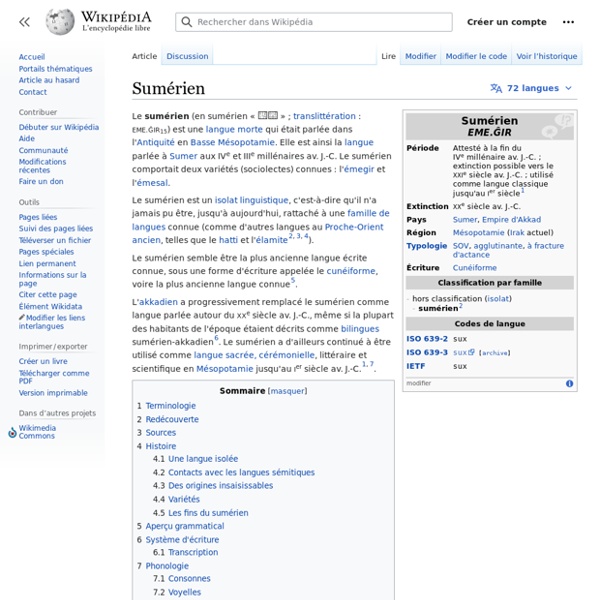Sumerian Mythology: Introduction
Sacred Texts Ancient Near East Index Previous Next p. 1 The study of Sumerian culture introduced by the present volume, Sumerian Mythology, is to be based largely on Sumerian literary sources; it will consist of the formulation of the spiritual and religious concepts of the Sumerians, together with the reconstructed text and translation of the Sumerian literary compositions in which these concepts are revealed. It is therefore very essential that the reader have a clear picture of the nature of our source material, which consists primarily of some three thousand tablets and fragments inscribed in the Sumerian language and dated approximately 1750 B. The decipherment of Sumerian differed from that of Accadian 3 and Egyptian in one significant detail, a detail p. 2 which proved to be one of the factors in hampering the progress of Sumerology to no inconsiderable extent. p. 3 p. 4 [paragraph continues] Layard was uncovering at Nineveh a large number of inscribed clay tablets. p. 5 p. 6 p. 7 p. 8
Timeline of World History - Category:History timelines — Wikimedia Commons
Sumer
Un article de Wikipédia, l'encyclopédie libre. Situation du Pays de Sumer Ayant été complètement oubliée après les débuts de notre ère, la civilisation de Sumer a été redécouverte durant la seconde moitié du XIXe siècle grâce aux fouilles de sites archéologiques du Sud mésopotamien, dont l'exploration s'est poursuivie par la suite, jusqu'à connaître un arrêt en raison des troubles politiques affectant l'Irak à partir des années 1990. En plus des redécouvertes architecturales et artistiques qui furent à plusieurs reprises remarquables, les fouilles ont permis la découverte de dizaines de milliers de tablettes inscrites en écriture cunéiforme, qui est la plus ancienne documentation écrite connue avec celle de l’Égypte antique. Sumer est donc l'une des plus anciennes civilisations historiques connues, ayant participé à la mise au point de ce système d'écriture durant les derniers siècles du IVe millénaire av. J. Conditions d'étude[modifier | modifier le code] Un peuple ? ↑ J. (de) Gebhard J.
Bible Maps, Timelines, Charts, Lineages
The Lost Tribes of Israel Locations where Israel taken captive View Migration after captivity View Israel's first settlement in Europe View The Roman Empire The Roman Empire at its Peak View Empire under Diocletian, Constantine View Rise and Fall of Rome's empire View Roman Empire in the First Century View Apostle Paul's Missionary Journeys All cities visited by Apostle Paul View Paul's travels after his conversion View Paul's FIRST Missionary Journey View His SECOND Journey View His THIRD Journey View His FOURTH Journey View Paul's LAST Missionary Journey View Area of Greatest Evangelistic Success View Maps of World Empires History's Greatest Empires See List The Roman Empire at its height View Alexander the Great's Empire View Assyrian and Babylonian Empires View Ancient Near East Empires View Persian Empire at its Height View Byzantine Empire in 1025 AD View Empire of Athens at its most powerful View Ottoman Empire at its Peak View Parthian Empire at its greatest extent View Biblical Family Trees World Maps
Jewish Timeline - a Brief History of the Jewish People in One Page
Greek Mythology: FAMILY TREE OF THE GREEK GODS
The complete family tree of the gods is displayed over eight indexed charts. The basic structure follows Hesiod's Theogony, but that author's genealogies have been expanded with a plethora of additional gods, spirits and creatures sourced from other classical sources. Where there is disagreement amongst ancient writers as to the genealogy of a certain character, the oldest and/or most popular source has been selected for the chart. An additional family tree depicts the divine genealogy given in Hesiod's Theogony. Click on any name in the chart to view the full page entry for that individual. INDEX Index of names in the family tree KEY Overview of and key to reading the charts CHART 0 The Main Gods A short tree containing just the main gods of the pantheon. CHART 1 The Cosmogony of the Gods The primordial gods or protogenoi. CHART 2 The Children of Night The spirit descendants of Khaos (Air), Nyx (Night) and Eris (Strife). CHART 4 The Children of Sea, Storm and Earth.
Greek Gods Family Tree
ludios.org
The Do It Yourself Scholar | Explore the best in free web learning.
Evernote
Google Drive - free online storage from Google
Dropbox
TinyScan - PDF scanner to scan document, receipt & notes
Pearltrees - Organize all your interests - web pages, docs, PDF, notes, file manager
Into the wild: 12 secluded homes and structures built away from civilisation
A mysterious cottage isolated from the rest of the world. Photo: Amusing Planet. Every now and then, we all dream of living a peace and quiet life off the grid. On this note, we've gathered some of the most secluded homes and structures in the world, all located off the beaten path, among Mother Nature, and deep into the wild. So take a few minutes and venture away from the cramped crowds and tedious traffic by picturing yourself relocating to these dwellings far, far away from civilisation – even if it's just through the land of your imagination. 1. Advertisement Our first thought when laying eyes on photos of The Crystal Mill; is this place even real? Photos by Lady Lone Ranger 2. Located on the island of Vágar in the Faroe Islands, the village of Gásadalur possessing breathtaking views holds a small population of 18. Photos by Shadowness 3. Finnish designer Robin Falck built this cabin in the middle of a forest so small it doesn't even require a permit. Photos by Robin Falck 4. 5. 6. 7.



